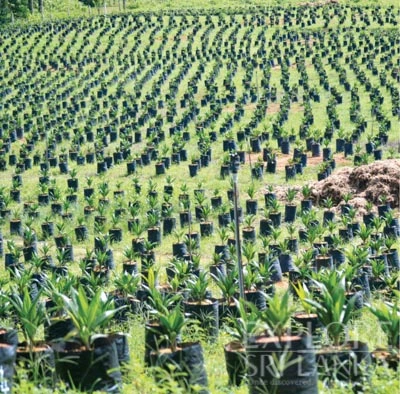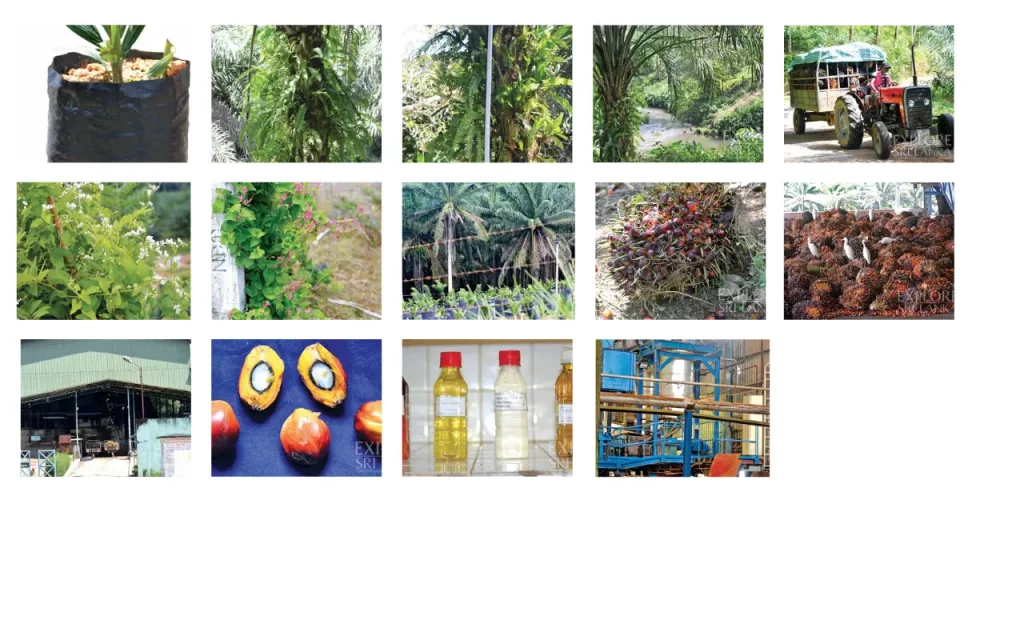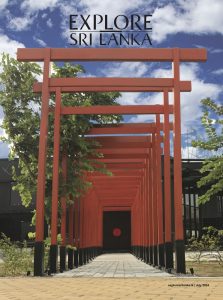
Sri Lanka discovered she held the secret of producing the world’s number two vegetable oil in the palm of her hand only in the late 1960s, when it was successfully shown that the ideal conditions for the palm tree to thrive existed in this country’s garden paradise.
Words and Photographs Manu Gunasena
In 1968, a British planter named Jerry Wales experimented with 68 palm plants by planting them at Nakiadeniya Estate, the then largest 3,500 tea and rubber plantation in the land, situated a few miles from Galle. In this low wetland zone, the soil was less acidic, not too sandy and not too gravelly. The temperature hovered between the optimum range of less than 300ºC and over 180ºC, even at night. The rainfall averaged an annual 2,500mm and was evenly distributed throughout the year, plus there was an average of six hours of indispensable sunshine a day. It provided ideal conditions for palm trees not only to grow but also to produce fruits in quantities that made their cultivation economically viable.
From the cradle of Nakiadeniya, the palm soon spread to Matara and Kalutara districts, which share similar climates. The combined palm oil production of those three districts has lowered the import bill by 15 percent, with greater reduction in sight. Plans are afoot to extend palm cultivation to Ratnapura, Kegalle and the Colombo districts. The Nakiadeniya plantation, managed by Watawala Plantations, a privatised regional plantation company, is the biggest palm estate in Sri Lanka with 3,000 acres under cultivation and produces half of the total of Sri Lankan palm oil output.
The production process at Nakiadeniya starts with the soaking of pre-heated imported palm seeds in water. They are then placed on gunnies until they turn grey. When they do, they are transferred into airtight bags which are inspected every two days and checked for fungus. If they are dry, they are sprayed with water to keep them moist. Generally germination takes place after two days.
Germinated seeds are removed and placed on a tray covered with polythene. Within 15 to 20 days they shoot and the root shows. They are then transplanted in small polythene bags where they remain for 30 days until, depending on the growth rate, they are transplanted into bigger bags. This happens when they produce three fronds and a shoot, proof that they have attained their palm puberty and are destined for greater heights.
These saplings are kept in the nursery for a period of 14 months after which those who have made the grade and qualified for adult membership, are transplanted to their permanent soil beds. For planting, spacing between the trees is kept at 9m x 9m x 9m. This triangular configuration enables the trees to receive adequate sunshine unhindered by the shade cast by surrounding trees. A hectare can hold 35 trees planted according to this formation. At present a hectare at Nakiadeniya produces on average 17 tons per year. The challenge is to increase the output.
After a further period of two and a half years the palm, having grown to a height of two and a half feet, begins to demonstrate its raison d’être; and all the tender love and care extended to the young plant, finally begin to fruit. But despite the precautions taken, the flower of Nakiadeniya’s hopes is not without its perils. As the fruits start to appear, birds peck it, boars dig it, rats gnaw it and squirrels chew it. Even the odd porcupine picks on it. Keeping the pest attack at bay is a perennial problem for planters and various methods are deployed to counter the threats, with constant vigilance observed at all times.
At Nakiadeniya, the agronomics of the owning company dictate that harvesting be done once every ten days. The objective is not only to obtain a crop but also to get the optimum bunch weight and the number of bunches per tree. Attention is paid to three stress factors that inhibit the tree from coming up with the economically vital, targeted numbers. These three are nutrient adequacy, sufficient soil moisture, and attention to the number of fronds on the tree. Lack of these requirements may render the flower to be of male gender in which case the inflorescent will not bear fruit.
Sri Lanka, though still a small time player, will be hoping one day to take her due place amongst palm giants and yield her palm to none
Once the harvesting, which is done manually with a long pole, is complete the focus is on getting the crop to the factory as quickly as possible. The moment the bunch is dislodged from the tree, time becomes of the essence. The oil begins to convert into pre fatty acid and processing must commence to preserve the ‘oilage’.
At the Nakiadeniya mill the crop is first inspected. The orange colour of the fruit will show that it is ripe enough to be extracted for oil. The fruit bunches are sterilised in the sterilisation tower to loosen the fruit’s grip on the stalk and to make it more malleable for separation.
It is then placed in a mechanical stripper, which rotates causing the fruits to be separated. Next it’s fed into a ‘digestor’, a cylindrical vessel to make the fruit pulpy. Pressing follows where two screws rotate with the fruit in the middle but this does not damage the kernel. All the oil and water and traces of fibre are squeezed out and transferred to a screen that filters the fibre.
The oil and water mix is then sent to a clarifier. The mixture is subjected to 90ºC continuous heating process, which separates the oil from the water and causes it to rise to the surface. The oil is collected from a fixed funnel and transported to storage tanks. It is now ready to be sold as crude oil.
Meanwhile through another process the kernel is separated and sent to a dryer. Here kernel oil is extracted; the residue left is used as poonac. The reddish crude oil in the tanks undergoes a refining process called Refined Bleached Deodorised (RBD) where the free fatty acid is removed. Two important by-products result, namely, RBD Palm Olein which is vegetable oil used for cooking, and RBD Palm Steering which is used to make soap products, candles and lubricating greases. Kernel oil is used to make margarine, chocolate confections and pharmaceuticals.
Sri Lanka, though still a small time player, will be hoping one day to take her due place amongst palm giants and yield her palm to none.






